Trump 2.0: The King’s Court
The world is watching the United States unleash a global trade war. Markets are tumbling. Allies are confused. Analysts are scrambling for logic to understand what the plan is.
But logic won’t help. Not here.
Because this is not a conventional presidency, and there is not a conventional plan. There are many plans that are fighting for dominance and that are championed by different groups. Some of these plans overlap with each other, while others are in conflict.
Trump Presidency 2.0 is a medieval aristocratic court dressed in modern clothes.
Around the King, rival factions battle for influence. Some dream of empire. Others, deregulation. Still others wage war over culture itself.
Throughout history, a court of advisors has always formed itself around the ruling King or Queen. The courtiers would vie with each other for power and influence over the King’s decisions, whilst always ensuring - if they were smart - that they never outshone their master.
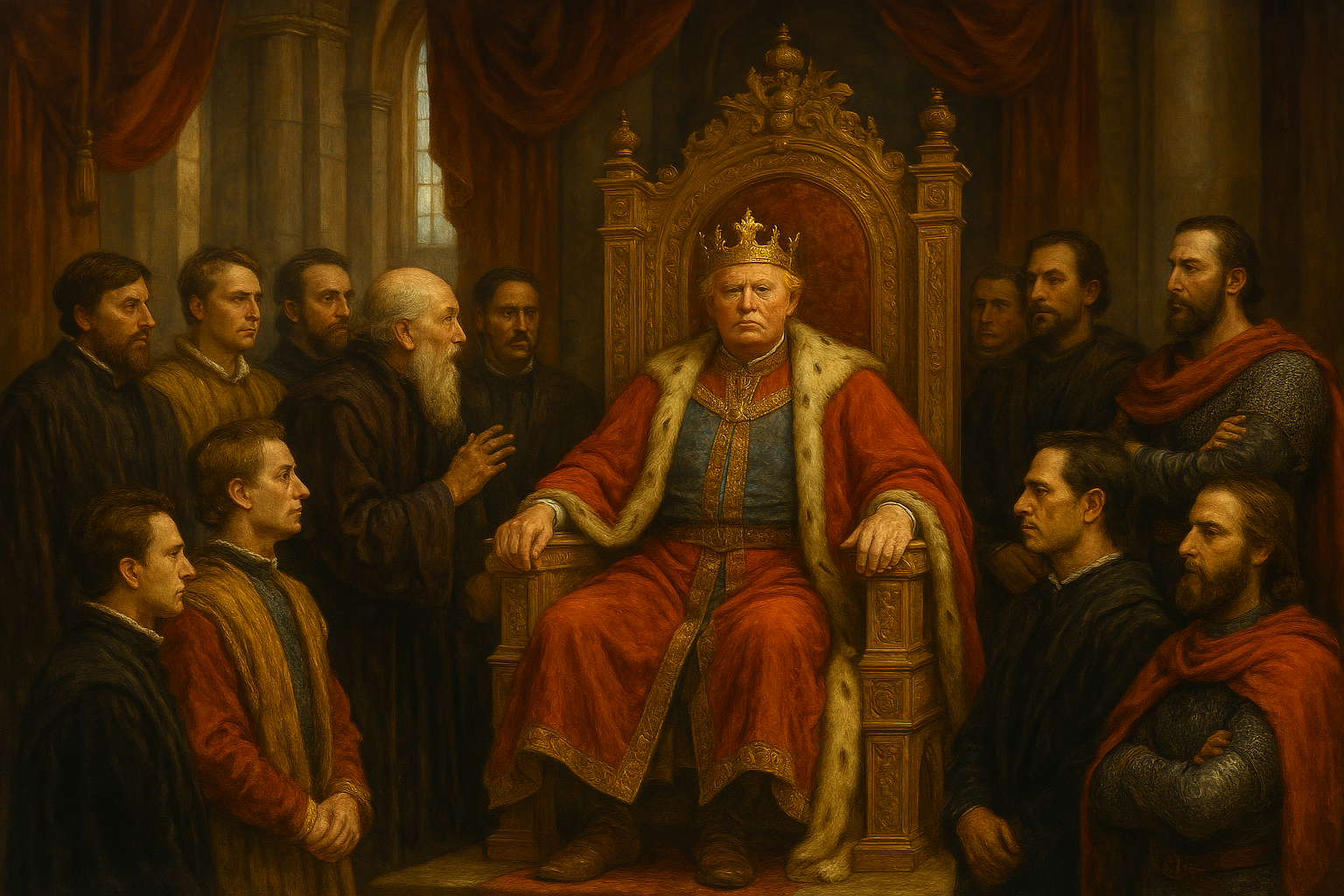
Trump acts in a way that means many have compared him to a King, yet few seem to make the obvious connection to the King’s Court. In this analysis, we’ll focus on each group’s support for (or opposition to) the recent trade war announcement.
We expect this framework will come in handy over the next four years of the current Trump administration.
There are five major courtier groupings within Trump’s Court that we see; and for each we’ve listed the most visible champion.
Tariff-walled alliance - Howard Lutnick
American empire - Steve Bannon
Revamped American-led order - Marco Rubio
Deregulation bros - Elon Musk
Culture warriors - Elon Musk
These are just the biggest and most visible groupings; everyone in Trump’s inner circle, including his family, is a courtier too.
An individual courtier can also belong to more than one group, as Elon Musk shows by being a senior player in both the Deregulation Bros and the Culture Warriors. Individuals also shift over time. Think of the groups like an alliance in an episode of Survivor: continuously shifting and reforming.
For now, we count five big groupings, but this could change over time if more groups emerge (or existing groups are sidelined).
Tariff-walled alliance
In our view this is currently the most influential group in Trump’s court. The broad tariffs on the whole world that were announced on April 2nd support this argument - although the next few weeks will likely be crucial for evaluating this group’s influence.
The tariff wall plan would see America put very high tariffs on every country that is not part of the alliance (like what was announced on April 2nd).
The U.S. would then offer allies the opportunity to join the trade alliance.
To join, a country must adopt the U.S. level tariff on every other non-alliance country. For example, if the U.S. has a 54% tariff on China, and Australia wanted to join, then Australia would need to also apply a 54% tariff on China (and match every other U.S. tariff on every other country).
In exchange for this, the allies get to keep U.S. military protection and also get access to lower tariff rates to the U.S.
The military protection part is really key here because it is what makes it an alliance and not just a free trade agreement. It is closer to an empire than a trading bloc.
The leading proponent of this view seems to be US Commerce Secretary Howard Lutnick, though Scott Bessent also appears to be in support.
In a private meeting at the Australian embassy in Washington in late February, Lutnick briefed Australian government and business leaders, including seven superannuation fund senior representatives, on what they should expect from the U.S.
The room was shocked by what they heard from Lutnick, as outlined in an AFR article written based on recollections of those present:
“Lutnick spoke about building a tariff wall. Allies and friends – such as Australia – could choose to be inside or outside the wall…Lutnick said much of Trump’s trade strategy was aimed at Beijing. So far, this includes a doubling of tariffs to 20 per cent, but this is only an opening shot in a trade war that could go much further unless Trump and Xi Jinping cut a deal.”
Meanwhile, the analysts looking at these tariffs through the lens of economic efficiency are saying that they make no sense. And they’re right!
These tariffs don’t make sense under an efficiency lens because for this group, that’s not what they are for - the tariffs are to prepare the United States (and her allies) so that they are capable of opposing China geopolitically. The tariffs are about building resilience and capacity, not efficiency. Ultimately, they are about preparing the United States to be able to fight a great power war, if it came to that.
To fight a major war, a country (or at least its allies) must be able to quickly manufacture all of the weapons needed for that war, while also being able to produce all of the goods and services that its society depends on.
Right now, the United States can’t do that, and in this group’s view, that needs to urgently change. Hence the dramatic April 2nd announcement.
If this group continues to hold the favor of the King then we should expect to see the U.S. begin to offer allies the opportunity to go “behind the tariff wall” and Australia may be offered a stark choice: start a trade war with our biggest trading partner in China, or lose American security protection.
This is not the only group pushing for a strong tariff wall. In fact, one group wants to go much further.
Hemispheric empire
The Hemispheric empire is one of the most radical groups, but just because it is radical doesn’t mean it isn't influential.
This group is championed by Steve Bannon, and at the beginning of the Trump 1.0 administration Bannon was initially so influential that he was on the cover of Time Magazine and was often thought to be the real power behind Trump’s throne.
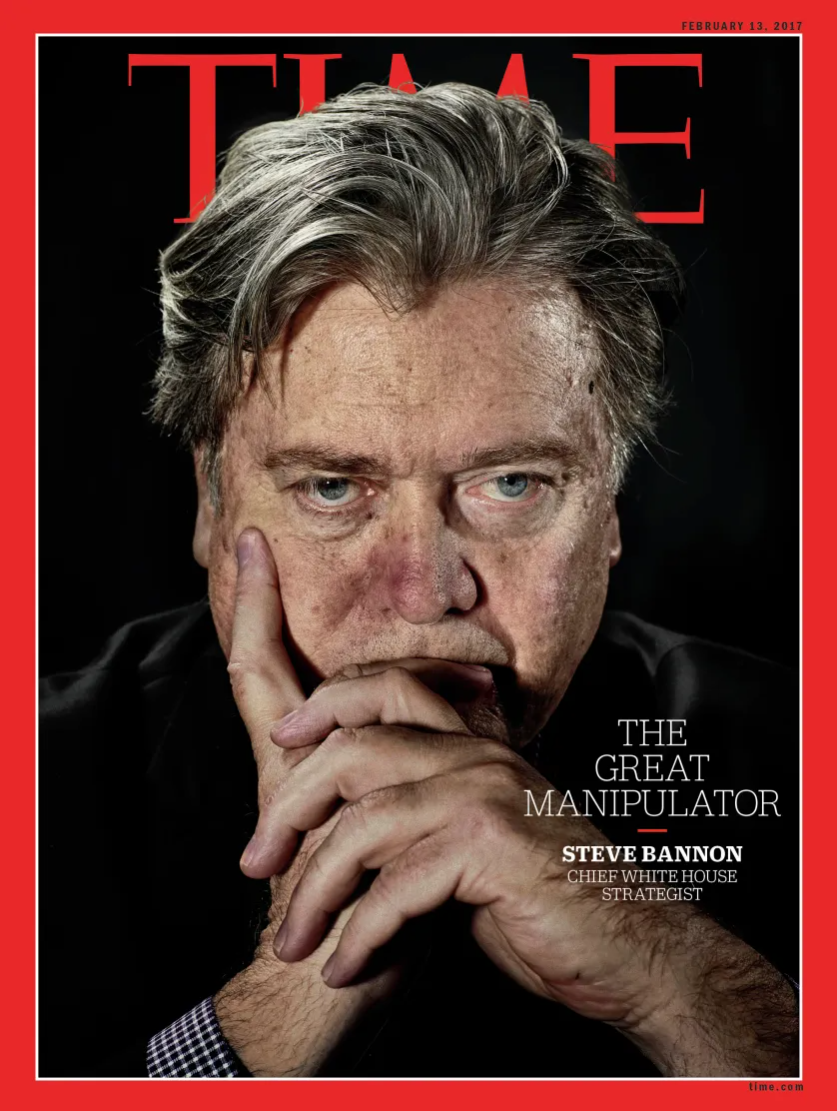
Outshining the master is a fatal flaw for any courtier (watch out Elon!), and Steve was soon dismissed from Trump’s Court and pushed out of the administration altogether.
Bannon didn’t go away, though, and continued to influence the MAGA narrative and online idea space. Today, Bannon is often called the ‘Godfather of the MAGA right’.
One of the core tenets of Bannon’s worldview is the importance of white Christian culture and spheres of influence. This focus on race, tradition, and religion means this group is quite fond of Putin’s Russia which it sees as a natural ally with white Christian values. To them, a “woke” Europe is, in many ways, a key enemy.
However, an even bigger enemy for this group is China, which it sees in a civilisational battle against the U.S. This group doesn't want a rules-based order. It wants an old-fashioned empire.
How influential is this seemingly radical group? Well, it is notable that Russia wasn’t on the tariff list for the recent Liberation Day announcements (Ukraine, meanwhile, received a 10% tariff).
For this group, a tariff wall would be just the start of something that looks much more like an old school empire. Ideas like the U.S. annexing Greenland or Canada might sound wild, but for this group, they aren’t. This group believes that might makes right, and wants the U.S. to be the mightiest empire of them all.
Here’s Steve Bannon talking to a Canadian interviewer about Trump’s proposal to make Canada the 51st state of America: “Let me be brutally frank. Geo-strategically, you don’t really have an option [but to join us] if you want your sovereignty because from the north, from the Arctic, it’s going to get encroached in a great power competition that you don’t have the ability to win.”
Bannon refers to this as ‘Hemispheric defence’ with the United States controlling North and South America, along with Greenland; the ‘Western Hemisphere’.
So, to the extent that this group is influential, we can expect it to support the Liberation Day tariffs (and more).
Revamped American-led order
If you liked the rules-based international order that has largely maintained peace over the past 80 years, and led to historic human flourishing around the world, then within Trump’s court, this is the group for you.
Most mainstream republicans would fall into this group, which wants to largely maintain the current rules-based order, but with a few changes. It wants to get the trade deficit down, and it could get behind a few targeted sanctions based on reasoned plans. This group also wants to pivot America’s focus toward China, and get Europeans to pay more for their defence. But it doesn’t want to ally with Russia either.
This group wants change, but the changes it wants are incremental, measured, manageable and organised.
Within Trump’s inner circle, the champion of this group is Marco Rubio, who appears to be fighting to maintain some kind of American-led rules-based order amidst an administration with quite different goals.
This group is generally very influential in the formal corridors of traditional power such as the Senate, but so far seems to hold less sway in the Trump administration.
We will know that this group is winning if the Liberation Day tariffs are quickly rolled back and replaced by specific targeted tariffs on particular industries.
Deregulation Broligarchs
This group wants deregulation. It is composed of elite billionaires, typically tech billionaires, who are sick of bureaucrats getting in their way.
While several other groups are focused on the world order, this group doesn't really care if there is a rules-based order, or who runs it, just so long as whoever is in charge doesn't interfere with their businesses.
This group loves the idea of the DOGE (department of government efficiency) because they see democratically elected governments as just another service provider to their empire, and they want their service provider to be cheap and efficient.
This group is not in favour of tariffs. In fact, they are actively against them. Not for any noble reasons about the value of international collaboration or fairness, but because tariffs are a tax, and taxes are bad for business.
All of the pro-Trump tech-elite fall into this group. Marc Andresson is a notable figure, but this group is also championed by Elon Musk. The tech elite were a very influential group in getting Trump elected. Musk alone donated US$288 million to Trump’s Election campaign and is obviously extremely influential.
This group is already breaking ranks on the tariff issue, with both Elon Musk and Bill Ackman speaking out on the tariff policy being misguided. Musk is even openly attacking the motivations of Peter Navarro, one of the intellectual champions of the tariff-wall alliance group.
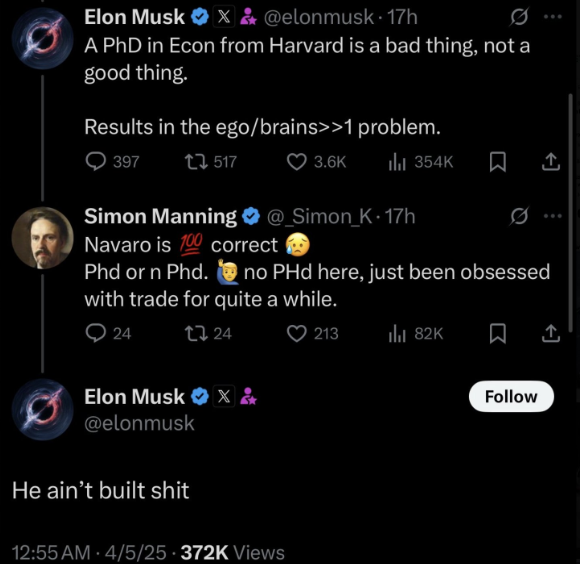
These battles are normally subtle and indirect, but there is now an open war in the King’s Court. This is a big deal because they could be at the vanguard in halting or reversing the Liberation Day tariffs, if their lobbying of the King is successful.
Although Elon is the leader of the deregulation broligarchs, it isn’t even his main motivation. For Elon, it’s really all about culture.
Culture warriors
This is a big and influential group, especially online. Some analysts think that the MAGA movement itself is best thought of as an online cultural movement.
The culture war is all about those U.S. battles that anyone who is even a little online will be all too familiar with. Stuff like DEI programs, transgender sports participation, ESG mandates, etc.
Elon has said his main motivation in supporting Trump was to “destroy the woke mind virus” after his son came out as transgender and disowned him.
Culture wars explain a lot of the early moves at DOGE, which has, thus far, seemed to focus much more on rooting out cultural opposition groups in government (like DEI committees) and not so much on genuine efficiency programs. U.S. Aid was completely disbanded as it was seen as supporting a plethora of progressive causes. The Department of Education is next on the chopping block, and again because of its role in shaping culture.
Understanding the culture war group is useful when considering where DOGE will target next, but so far it has been a neutral player on the tariffs issue.
The cloud of personal patronage (or what critics call grift)
Sitting around and on top and inside of all of these groups is a cloud of personal patronage whereby individual courtiers petition the King for decisions which will personally enrich or benefit themselves. This is inevitable in any royal court, although it does appear to be more widespread in this one than in most.
This cloud of patronage doesn’t appear to have much of a role in the tariffs so far, but keep an eye out. If the U.S. starts to negotiate individual specific exemptions to the tariffs for particular countries, industries, or businesses, then patronage could be a factor in which ones win an exemption.
The Wild King
Finally, we have the King himself. Trump is a particularly interesting King because he is also a wild card.
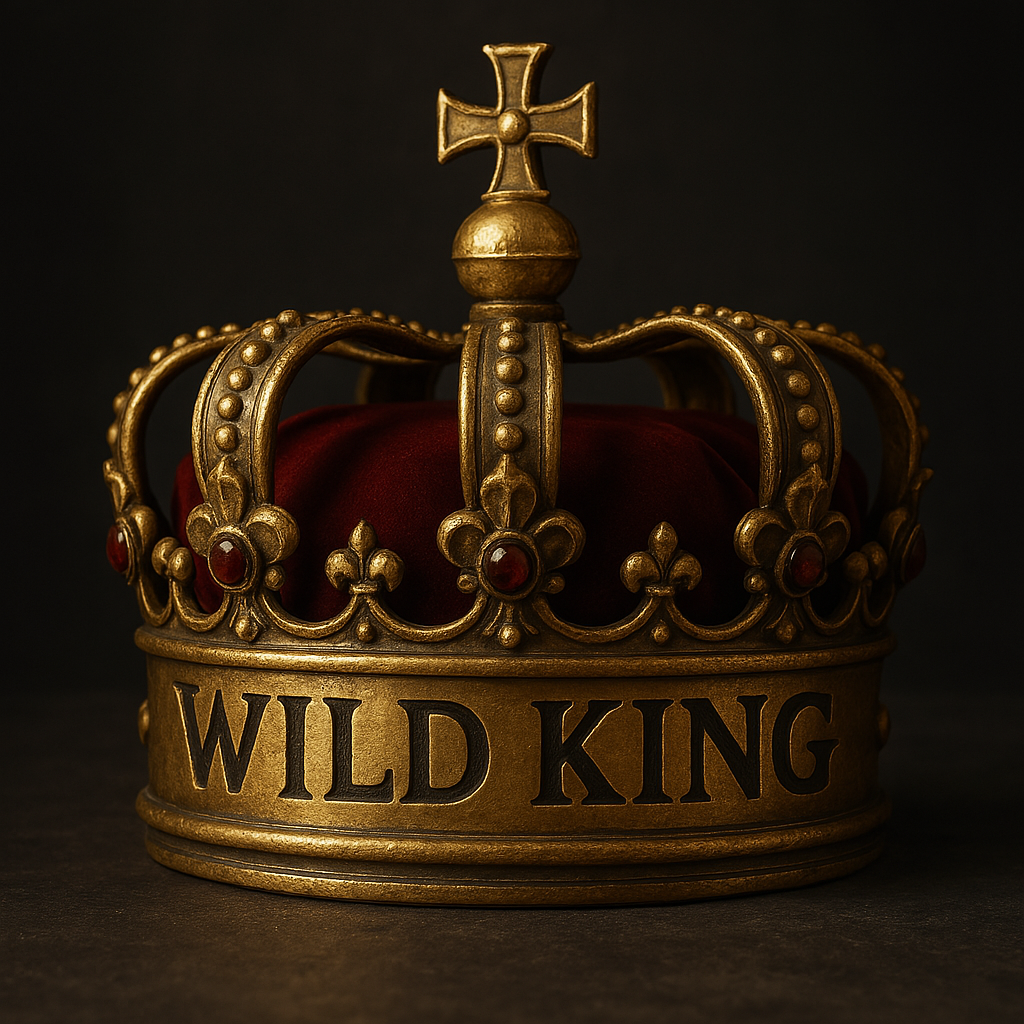
Some powerful rulers are heavily committed to a particular worldview. Putin, for example, seems genuinely committed to the idea of restoring the Russian empire, and his public comments are steeped in hundreds of years of historical references.
Trump does have his preferences. He clearly likes tariffs, for example, and has for decades.
One of his favourite quotes is “Tariff is the most beautiful word in the dictionary.” This love of tariffs is how he has attracted so many other tariff fans to his court.
However, Trump also doesn’t appear to be a fanatic of a particular ideology. He just doesn't seem to care about that stuff, much.
Take the current moment: last Wednesday evening, Trump dropped the biggest change to the global order in 80 years with his Liberation Day tariffs on almost the entire world. He then went and played golf for a few days.
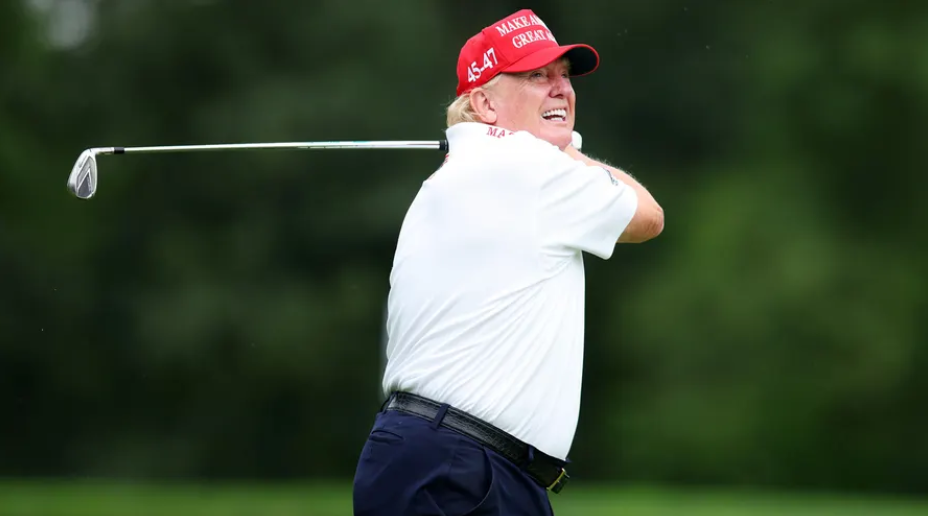
This lack of commitment to any particular ideology provides a lot of room for the courtiers to influence him in a wide range of different directions.
Dropping a bombshell and then driving away in a golf cart while the courtiers all squabble over what happens next is also the kind of power move that a Wild King loves.
Layer on top of this that Trump enjoys being unpredictable. Before becoming President, Trump was the world’s biggest reality TV star. He has a natural talent for gaining attention, and in order to keep getting attention, he needs to make increasingly shocking and outlandish statements.
Some of Trump’s wildest ideas (like ‘Trump Gaza’) could have originally come from a particular courtier (in this case, son-in-law Jared Kushner is suspected), but they can also be seen as Trump reaching for something shocking to dazzle his audience and reel their attention back in. As the audience gets used to each level of shock, the next announcement needs to be even more shocking in order to keep grabbing attention.
In Trump 1.0, the Wild King was surrounded almost entirely by mainstream republicans that would fit into the Revamped American-led order camp. Trump might make some wild statements, but these advisors limited his freedom of movement, at times actively working to limit his most extreme moves.
Today, however, in Trump 2.0, the Wild King has a wide open space for movement, and plenty of courtiers that will encourage him to move even further in certain directions.
This wild-card attention-grabbing makes it difficult to read too much into any policy announcement. To see if a new wild policy has legs, it is more useful to consider if the policy matches one of the leading group’s interests.
Trump also likes to make a big first ask in a negotiation, so no matter which team ultimately wins out, it is likely that the announced tariffs are a high water mark for what gets negotiated for most countries.
The tariff battle
This framework means that we shouldn’t think of the Trump administration as a single entity, but as an aristocratic court with groups that rise and fall in the King’s favour.
We should, therefore, expect that where these tariffs land will depend on which team is winning. This is useful when we process a particular piece of news flow to determine what it means.
For example, Steve Bannon is openly at war with Elon Musk calling him “a parasitic illegal immigrant” who doesn’t respect “the country’s history, tradition or values”. If Elon Musk is pushed out of Trump’s court, that would be a big hit to the Deregulation Broligarch team, and we can then expect that it is more likely that the high tariffs stick.
Conversely, if mainstream Republicans find their voice and start denouncing the tariffs, then that would add weight to the Revamped American-led order group, and we should expect the tariffs to be watered down.
This framework also means that we should not be analysing the Liberation Day tariffs purely in terms of economic efficiency. Several of the key groups - including the currently leading ‘Tariff-walled alliance’ do not appear to be primarily driven by economic efficiency, but rather by geopolitics, resilience, and ultimately preparation for a potential war.
If the market continues to fall, then we can expect that to add to the support for those groups that do care about economic efficiency (like the Deregulation Broligarchs). And so this man-made sell-off could be self-correcting.
Although this framework can’t predict which group will ultimately win, it does allow us to respond quickly to process any news. A King’s Court is driven by power politics, personalities, and the clash of warring worldviews, much more than any sober rational analysis. Reading Machiavelli or watching a series of Survivor is better preparation for understanding what is happening than brushing up on our Excel modelling skills.
In this court, policy is not forged by principle, but by proximity to the throne. The tariffs may rise or fall, not by logical analysis, but by who whispers loudest in the King’s ear. And so, investors must do what every courtier has done for centuries: read the room, watch the throne, and never forget, this is a game of power, played with real-world stakes.
The King plays golf. The courtiers draw swords. The empire holds its breath.

